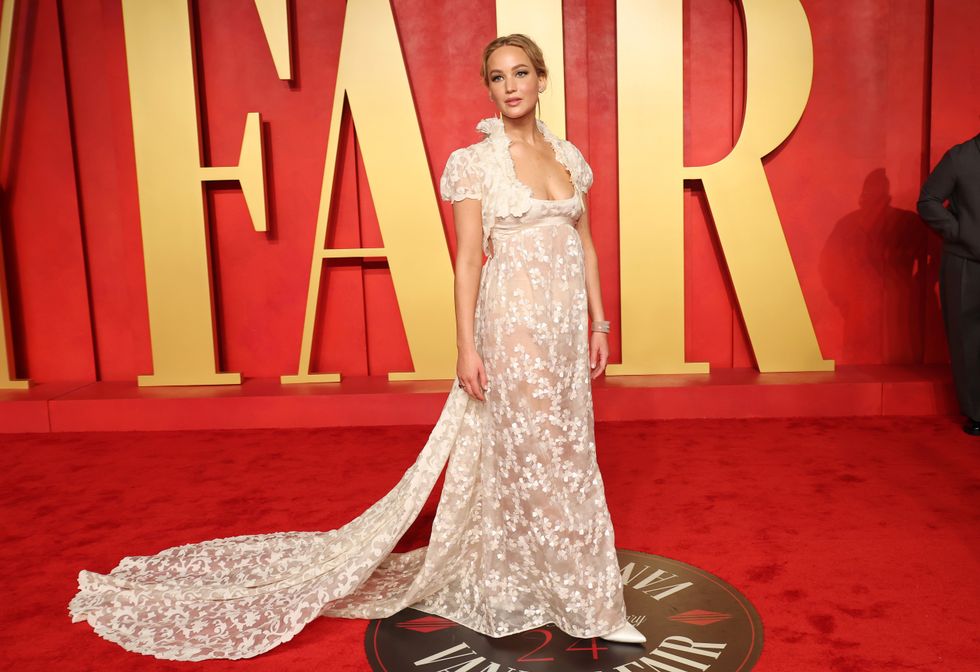
Hollywood’s Archival Fashion Arms Race
BY
Joan Summers | Mar 18, 2024

The Oscars have come and gone. Designers were worn and shown off, specifically those of yesteryear. In the current red carpet climate, stylists have grown bold in their archive pulls, or desperate. It depends on who you ask.
There’s a fashion war that rages behind the scenes of each awards season that defines most of what trickles in front of pap cameras. In this latest iteration of the arms race, the hot commodities on the market are archival runway statement pieces: Jennifer Lawrence in 1996 Givenchy couture, Margot Robbie in Mugler Spring 1996, Carey Mulligan in a recreated 1951 Balenciaga gown, Anya Taylor-Joy in a recreation of essentially the same 1949 Dior gown that Natalie Portman already wore at Cannes, Cardi B in Atelier Versace spring 2003 and Sydney Sweeney in Angelina Jolie’s 2004 Marc Bauwer gown.
I’d like to step around any grandiose feelings about these archival pieces, as I find such contrivances rather plain. If not plain, then immaterial. Rather, how these pieces fit within a broader swath of carpet history is much more interesting. Take Sydney Sweeney’s appearance at Vanity Fair’s afterparty — about as important online as the main carpet itself — in Angelina Jolie’s 2004 Oscars dress. Jolie wasn’t nominated that year, and instead presented the award for Art Direction. All things considered, it reads as a rather random pull for Sweeney, which even her stylist Molly Dickson noted in Vogue: “There are only a select few iconic archival pieces, or even vintage pieces. As a stylist, it’s my job to source the market. We reach out to a ton of different vintage sellers to try to find really cool vintage pieces, but it's tough, because there are only a few that are in great quality.”
Earlier in the interview, she offhandedly comments that while archive pieces are sustainable, they also present actors like Sweeney “a new way to present themselves.” After the dueling debacles of Madame Web and Anyone But You, or that ridiculous kerfuffle about her body, it’s easy to see why they’d hitch her rising star to a trend that's proven itself a headline generator for Sweeney’s contemporaries. Likewise, there’s the economics to consider.Law Roach has spearheaded archival garments on the carpet, although the urge to pull deeper and deeper has infected just about everyone, which makes it difficult to tamp down my cynicism in this latest turning of the carpet trend cycle. We the fashion press are tuned in because vintage couture is novel again, and our jobs concern the garments at play. That utility, though, is only one piece of a broader strategy that must aim higher for that engagement to translate into box office success or commercial exposure for a client.
For some time now, it hasn’t been enough for brands or stylists or studios to expect a hot-or-not write ups in next week’s glossies, or find an actor placed in a roundup that’s nearly identical across numerous publications. An infinite amount of social media accounts now compete with each other for engagement under Twitter’s recent paid user overhaul, which fundamentally changed how photos of the carpet reaches consumers, or where the cash from all that attention is deposited.
Roach, who pulled that iconic Mugler “Maschinenmensch” suit from the archive for the Dune: Part Two press tour, has gestured at such developments in the field. In an interview with W, he revealed that studio heads thanked him for the social media blitz he created around that press tour: “What we do is just as powerful as that trailer that’s running on social media or in the theater. It’s the newest ideation of what it means to promote a movie.” It’s rare commentary from a stylist of his caliber on the opaque commercial function of the carpet in a time when that role was widely challenged post-pandemic.
As he also notes, his stylistic direction is very literal, arm in arm with the tone of the material his client is presenting on the red carpet. Zendaya plays a warrior and future consort to the emperor of the galaxy in Dune. Why wouldn’t she be in armor on the carpet? It’s why Sweeney’s inclusion of Angelina Jolie’s Oscars dress stuck out as a turning point in the current climate of archival pulls. One can feel the industry peeping over Roach’s shoulder, eager to borrow his notes.

If only it were as simple as expecting the same result when sending down the second recreation of a historically significant Dior dress. The narrative around any one gown has never moved faster, as it’s hard to be moved en masse by elegant couture when a screen with an endless scroll has been surgically attached to the hand. Arm in arm, the numerous PopCrave-likes and paid Twitter engagement farms chase each other down the drain of the attention economy, polluting the step-and-repeat with an endless procession of cut-and-pasted observations. There’s only so much room in the trending sidebar, so Cardi B’s Atelier Versace dress completely slips past me, until I sit down a week later to process, and fire off some critical texts to peers and friends post-Awards season.
We titter amongst ourselves while Diet Prada posts yet another roundup on Instagram. Soon, every account hot on its coattails is asking their easily inflamed audiences: “Thoughts?” The average social media consumer is last to the fray, and I’d imagine studios make complicated social engagement graphs for their board meetings while stylists grow weary of their work being torn apart online. Next season, Law Roach and his many students set some new standard to chase after, and the great wheel turns again.
Roach has made his own opinions about the entire ordeal known. Amid the Oscars carpet, he tweeted: “It’s not even fun anymore.”
Photos via Getty Images